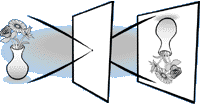|

How does a hole in the bottom of a Pringles® can make a picture
of the world?
The hole doesn't make the picture. The image of the world is always there.
All the hole does is make it possible for you to see it.
Suppose you point your Pringles® Pinhole at a brightly lit bouquet
of flowers. Light reflects off the red rose, the blue iris, the white daisy,
and the green leaves. If you hold a piece of white paper near the bouquet,
some of that reflected light will shine on the paper-but it won't look like
anything. That's because light bouncing off the red rose ends up overlapping
with light bouncing off the blue iris, the white daisy, and the green leaves.
There are many images of the bouquet on the paper-but they overlap with
one another, and the colors all blend together, making a jumble of light.
|
The hole isolates a small part of the light, sorting a single image from
the jumble. Only a few of the light rays reflecting off each point on the
rose are traveling in a direction that will let them pass through the hole.
The same is true for light bouncing off all the other flowers in the bouquet.
On the other side of the hole, these light rays reveal an image of the bouquet.

|

You've made a camera! This kind of camera is called a camera obscura-which
is Latin for "dark chamber." The first camera obscuras were small
rooms that were completely dark except for a tiny hole in a wall that let
in a dot of sunlight. People in the room saw an image of the trees and sky
on the wall opposite the hole-and were amazed when the image disappeared
at sunset!
|
The Home Scientists in the Graff family improved their Pringles® Pinhole
by using a foam soda can holder as an eyepiece. It made the inside of the
tube dark, and was easier to use for people who wear glasses.
|